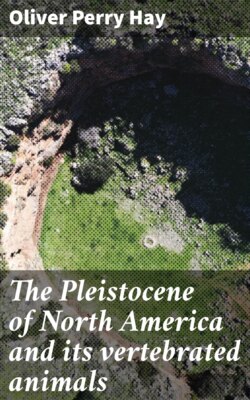Читать книгу The Pleistocene of North America and its vertebrated animals - Oliver Perry Hay - Страница 42
На сайте Литреса книга снята с продажи.
INDIANA.
ОглавлениеTable of Contents
(Map 3.)
The only member of the order of Xenarthra that has yet been found in this State is Megalonyx jeffersonii, and this in only one place, viz, Evansville.
1. Evansville, Vanderburg County.—In 1854 (Proc. Acad. Nat. Sci. Phila., vol. VII, pp. 199–200), Leidy described a collection of vertebrate fossils secured by Mr. Francis A. Lincke from the banks of the Ohio River, near the mouth of Pigeon Creek, a short distance below Evansville. At that time and locality bones were usually found sticking out of the bank when the water in the river was low. The bones sent to Leidy were thoroughly impregnated with oxide of iron, which served as a cement to adhering pebbles, sand, and fragments of Unios and shells of other fresh-water mollusks. The remains of the megalonyx consisted of parts of two tibiæ of young individuals, an atlas, a fragment of a heel-bone, a metacarpal and a metatarsal bone, and a claw phalanx. With these were discovered a fragment of a cervical vertebra of a species of bison, various bones of the Virginia deer, a vertebra of a horse, probably Equus complicatus, a tooth of the tapir Tapirus haysii, and a part of the upper jaw of the wolf now known as Ænocyon dirus, but at that time called by Leidy Canis primævus.
The principal interest in these remains is to determine at what time during the Pleistocene the megalonyx lived. Some indications may be obtained from a study of its companions. From a part of a cervical vertebra Leidy could not name the bison, but it belonged probably to one of the extinct species. The deer is yet living, but appears to have existed through most of the Pleistocene. The species of horse represented is extinct, and there is no evidence that it lived after the Wisconsin glacial stage. Its latest representatives probably lived during the Sangamon stage. No tapir is known to have lived after the Wisconsin stage. The wolf, Ænocyon dirus, is believed to be represented in the numerous individuals found in the asphalt beds of Los Angeles, California, probably equivalent in age to the Aftonian.
Mr. Arthur C. Veatch (Jour. Geology, vol. VI, pp. 257–272) has given an account of changes which have occurred along the Ohio River in Spencer County, Indiana, about 25 miles above Evansville, since late Pliocene times. According to his investigations, the valley of the river was deeply excavated into the Carboniferous rocks during the Ozarkian uplift. Since that time, during the Pleistocene epoch, that great valley has been, to a large extent, filled up by alluvial deposits. While the greater part of these deposits were laid down during glacial stages, it is not improbable that some were made during the Aftonian stage and that a part of these yet exist along the borders of the river. It is still more probable that Sangamon beds yet exist there and that the bones Leidy described were found here.
Many bones of the megalonyx were described by Leidy (Smithson. Contrib. Knowl., vol. VII, article V) from a locality 5 or 6 miles below Henderson, Kentucky, not much more than 10 miles in a straight line from the mouth of Pigeon Creek. The bone-bed was said by Dr. D. D. Owen (op. cit., p. 7) to be about 5 feet above ordinary low-water. In the same bed Owen found abundant remains of the deer. He seemed to regard this bone-bed as a continuation of that existing at Pigeon Creek.
Megalonyx has been found at Bigbone Lick, between Cincinnati and Louisville, associated with Equus complicatus, two species of extinct bisons, and the Virginia deer, in deposits overlying Illinoian drift and hence belonging, in part at least, to the Sangamon. These deposits are, however, at a higher level, being now submerged only at times of very high-water in the Ohio River. If these and the Pigeon Creek beds are of the same age, we may suppose that the animals entombed at the latter place were buried low down in the deep valley along the river banks, while those at Bigbone became covered up around salt springs at a higher level.
